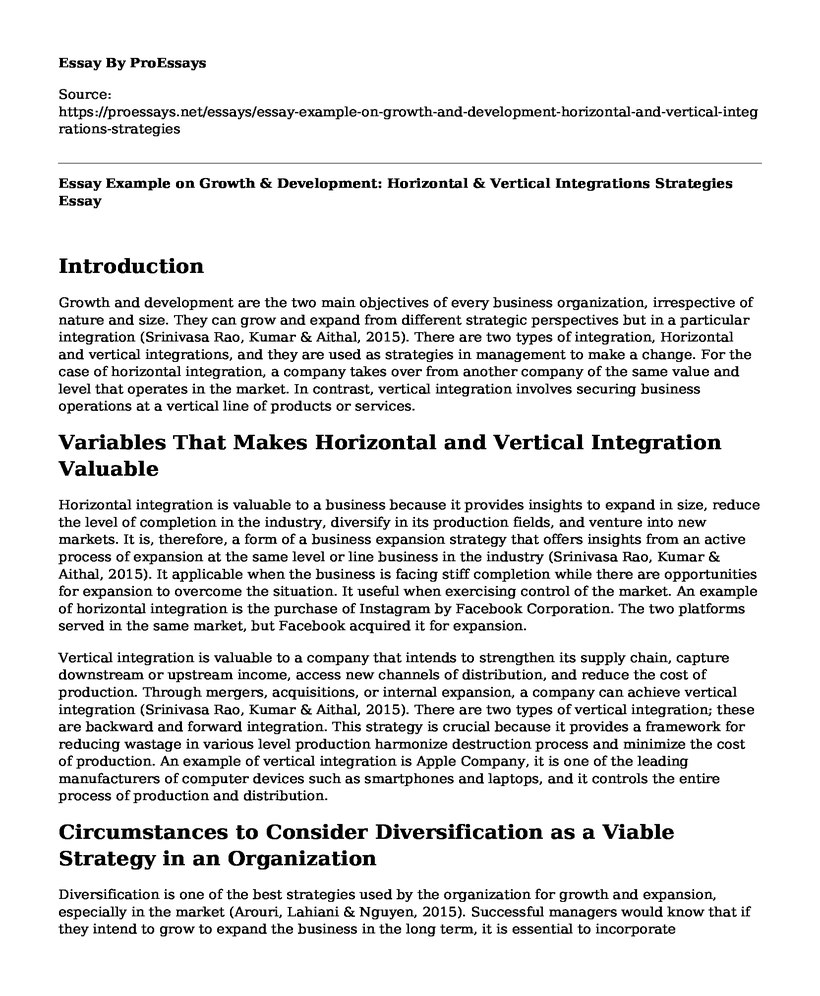Introduction
Growth and development are the two main objectives of every business organization, irrespective of nature and size. They can grow and expand from different strategic perspectives but in a particular integration (Srinivasa Rao, Kumar & Aithal, 2015). There are two types of integration, Horizontal and vertical integrations, and they are used as strategies in management to make a change. For the case of horizontal integration, a company takes over from another company of the same value and level that operates in the market. In contrast, vertical integration involves securing business operations at a vertical line of products or services.
Variables That Makes Horizontal and Vertical Integration Valuable
Horizontal integration is valuable to a business because it provides insights to expand in size, reduce the level of completion in the industry, diversify in its production fields, and venture into new markets. It is, therefore, a form of a business expansion strategy that offers insights from an active process of expansion at the same level or line business in the industry (Srinivasa Rao, Kumar & Aithal, 2015). It applicable when the business is facing stiff completion while there are opportunities for expansion to overcome the situation. It useful when exercising control of the market. An example of horizontal integration is the purchase of Instagram by Facebook Corporation. The two platforms served in the same market, but Facebook acquired it for expansion.
Vertical integration is valuable to a company that intends to strengthen its supply chain, capture downstream or upstream income, access new channels of distribution, and reduce the cost of production. Through mergers, acquisitions, or internal expansion, a company can achieve vertical integration (Srinivasa Rao, Kumar & Aithal, 2015). There are two types of vertical integration; these are backward and forward integration. This strategy is crucial because it provides a framework for reducing wastage in various level production harmonize destruction process and minimize the cost of production. An example of vertical integration is Apple Company, it is one of the leading manufacturers of computer devices such as smartphones and laptops, and it controls the entire process of production and distribution.
Circumstances to Consider Diversification as a Viable Strategy in an Organization
Diversification is one of the best strategies used by the organization for growth and expansion, especially in the market (Arouri, Lahiani & Nguyen, 2015). Successful managers would know that if they intend to grow to expand the business in the long term, it is essential to incorporate diversification strategy. Several circumstances call for diversification strategy; they include:
When There Is Need to Ignite Growth
A business goes through different stages after the start; it begins with phenomenal growth and then a plateau phase; in this situation, the business may slow down. It is a plateau phase that the business must consider diversification strategy to ignite growth, such as adding new lines of production and venturing into new markets.
When There Is Need to Survive
A firm that has a narrow range of production or market would have a finite access to many customers. This situation poses risks of high completion; at some point, the business may be at a maximum penetration while the cost of running the business may outweigh growth opportunities. The company is therefore pushed into a situation of limited control of resources and another essential factor of business. To overcome this situation, the common can consider diversification strategy to stabilize cash flow.
Benefits of Global Strategy to an Organization
Globalization and the growth of technology have provided more opportunities for business globally; this has given rise to global strategy (Lasserre, 2017). Companies can expand in production and venture into new markets globally. An organization can benefit from this strategy through the expansion of the market and target customers. It also enables an organization to succeed in a diversification strategy.
In a country where the economy is significant that it can't accommodate many businesses especially growing businesses, the global strategy would be available to enable the organization to venture into new markets, access new customers and diversify in its production. When a company is facing stiff competition as a result of a fixed economy, it would be best to opt for international markets using global strategy.
References
Srinivasa Rao, A. B., Kumar, P. M., & Aithal, P. S. (2015). Strategic Planning in Higher Education Institutions: A Case Study of SIMS-VISION 2025. International Journal of Educational Science and Research (IJESR) ISSN (P), 2249-6947.
Lasserre, P. (2017). Global Strategic Management. Macmillan International Higher Education.
Arouri, M. E. H., Lahiani, A., & Nguyen, D. K. (2015). World gold prices and stock returns in China: insights for hedging and diversification strategies. Economic Modelling, 44, 273-282.
Cite this page
Essay Example on Growth & Development: Horizontal & Vertical Integrations Strategies. (2023, Jul 21). Retrieved from https://proessays.net/essays/essay-example-on-growth-and-development-horizontal-and-vertical-integrations-strategies
If you are the original author of this essay and no longer wish to have it published on the ProEssays website, please click below to request its removal:
- Decision Making in Business Venturing Essay
- Corporates Misdeeds: The Biggest Business Scandals of 2017 Essay
- Article Analysis Essay on Colour of Bile Vomiting in Intestinal Obstruction in the Newborn
- Accounting Fraud at WolrdCom Case Study Paper Example
- Paper Example on RFID: Automating Industries for Cost-Saving & Efficiency
- Essay Example on Organizational Design: Enhancing Business Structure and Efficiency
- Essay on Strategic Organizational Development: Information Management Key to Knowledge Mgmt Systems







